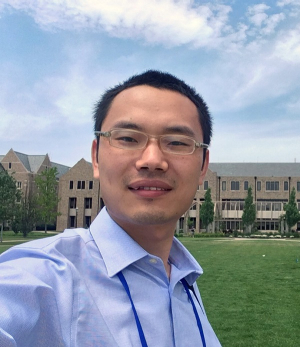Research brings self-powered wearable electronics closer to reality
Wearable electronics – from smartwatches to fitness trackers – are not just trendy and fashionable accessories, but an integral part of many people’s lives. People use these devices to log the number of steps taken, monitor heart rates and sleep patterns, count calories and more.
The demand for wearable devices has spurred advances, such as more compact designs and more complex activity tracking (broken down into different sports), which require more efficient power storage. Traditional batteries can’t meet customer’s expectations of smaller devices and longer run times between chargings. As a result, researchers are working to identify or create alternate power supplies.
Jie Chen, a doctoral candidate in materials science and engineering at the UH Cullen College of Engineering, recently tackled the issue in an article published in the prestigious Nano Energy journal.
“It would be really amazing if one day we could have electronics that work forever – without the need for charging or replacing the batteries,” Chen said. “Energy harvesting from biomechanical energy is one of the promising approaches to make this a reality.”
Biomechanical energy is power harvested from human motion, such as walking. It is widely available to almost every living person.
Chen is the lead author of the article titled “Biocompatible and sustainable power supply for self-powered wearable and implantable electronics using III-nitride thin-film-based flexible piezoelectric generator.” Co-authors include Jae-Hyun Ryou, associate professor of mechanical engineering and Chen’s faculty advisor; Seungkyu Oh, a UH postdoctoral fellow; Noor Nabulsi, a UH mechanical engineering senior and an undergraduate research assistant; Heidi Johnson, a UH undergraduate research fellow and Weijie Wange, a UH doctoral candidate in mechanical engineering.
The article shares research that demonstrates the capability of harvesting biomechanical energy using a high-durable and biocompatible material, called III-nitride thin film, in flexible piezoelectric generators.
At present, state-of-the-art biomechanical energy harvesters or generators suffer from low stability, low power output or the use of toxic elements, Chen said.
“Group III-nitride thin film-based piezoelectric generator developed in our research overcomes most of these drawbacks and could make the self-powered electronics one step closer to reality,” he added.
However, the research team grew the thin film on silicon by epitaxy, which is expensive and makes it difficult to fabricate the flexible device. The Ryou Group is now working to develop new approaches to deposit the group III-nitride thin film directly onto a flexible material, like metal foils, to reduce cost and simplify fabrication.
To read the article, please visit: https://www.sciencedirect.com/science/article/pii/S2211285518309935

